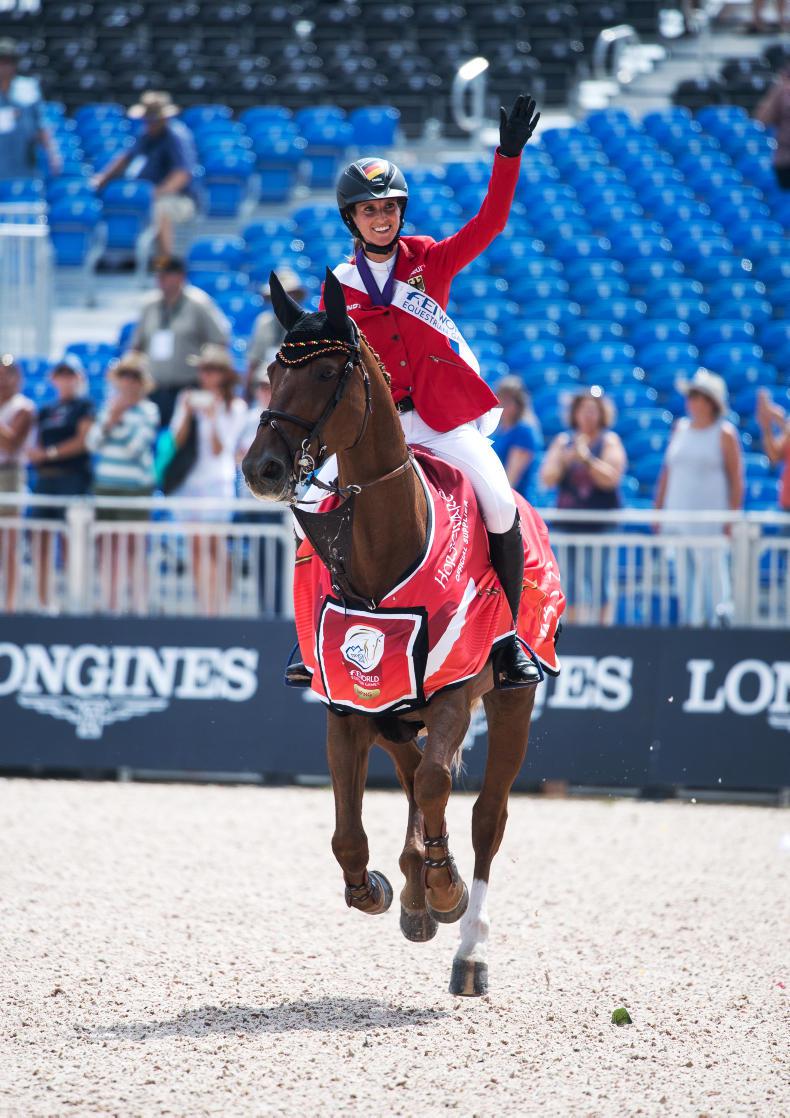SO the World Equestrian Games are over and from a show jumping angle, the one horse that made international headlines after her impeccable Tryon record was DSP Alice. The DSP prefix stands for the rebranded Deutsche Sportpferde, or German Sport Horse, an amalgamation of several studbooks in southern and east-central Germany.
Included in the new studbook is the former Pferdezuchtverband Sachsen-Thüringen e.V (SATHU) from the region where DSP Alice was bred. Three years ago, it languished in 27th place in the World Breeding Federation for Sport Horses (WBFSH)’s show jumping studbook rankings.
Now the regrouped Deutsches Sportpferde lies in 13th position, one place above the Irish Sport Horse studbook, in the WBFSH penultimate show jumping rankings for this year. Ranked third in their August results, behind Legend of Love and DSP Cashmoaker, was the ‘dark horse’ DSP Alice.
By the well-bred Holsteiner stallion Askari, whose back pedigree reads like a Who’s Who of foundation sires in Alme, Calypso, Landgraf and Cor de la Bryere, DSP Alice’s damline is more rustic. Her dam Landblume’s topline does include the great Landgraf, similar to most Irish mares tracing back to King of Diamonds or Clover Hill and otherwise there are mainly Mecklenburg and Saxony-Anhalt bloodlines seen in this family.
Not that her lack of a ‘fashionable’ pedigree prevented her from becoming the undisputed world champion. And the DSP has a new poster child to rival Michael Jung’s pair of La Biosthetique Sam and Rocana, plus Tina Cooke’s Billy The Red, individual ninth at Tryon International.
ASK A MARE
The 12-year-old DSP Alice becomes the first mare to win World Equestrian Games show jumping final in its current format. She joins a stellar group of medal-winning mares from previous world championships, including the Water Serpent-sired Gowran Girl. She won gold for Raimondo D’Inzeo in the 1960 World Championships at Venice.
Another Irish-bred mare was Liscalgot, that sealed Dermott Lennon’s historic gold medal in Jerez de la Frontera in 2002. In that final, where the last four riders swapped horses, it was another mare – Fein Cera – that recorded a faultless scoresheet.
Three German-bred mares Halla (1954, 1955), Simona (1974) and the wall-eyed chesnut San Patrignano Weihaiwej (1994) claimed gold too in their day for Hans Guenter Winkler, Hartwig Steenken and Franke Sloothaak.
There was another gold medallist-winning mare at Tryon in the form of Grand Prix Special winner Bella Rose (s. Belissimo) for Isabell Werth and in third was Charlotte Dujardin’s exciting prospect Mount St John Freestyle (Fidermark).
And of course the turbo-charged Rioghan Rua, as the smallest horse in the championships, gave Margaret Kinsella a priceless experience as one of the few owner-breeders at Tryon International.
RANKINGS RACE
Just as the historic clean sweep at Lanaken gave Irish sport horse breeding a platform, the Irish team silver medal at Tryon provided a timely boost too. The KWPN is the second-largest studbook supplier, after the Irish Sport Horse, to British eventing and the all-round solid performance by the Irish-breds is a golden marketing opportunity – even in the face of Brexit.
Aside from the Irish team, Australia had the most Irish-breds (three) on their WEG team and although British-bred, Mr Chunky’s performance could be claimed as another advertisement for traditional Irish bloodlines.
Allstar B was 72nd in the WBFSH penultimate rankings, so it will be interesting to see how high the Tryon results propel the Dutch-bred in the final results, due out early next month.
In the previous World Equestrian Games year, Opgun Louvo ranked 65th in the second-last rankings before jumping to fifth in the final results for 2016.
As for the eventing studbook race, Allstar B and eighth-placed Cekatinka’s WEG results will boost the second-placed KWPN, just 27 points behind the reigning Irish Sport Horse titleholders.
The biggest jump will surely involve DSP Alice, ranked a mere 194th in last month’s WBFSH rankings.
